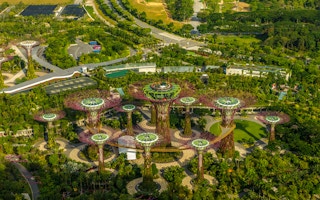“What unites us on an urban level is more unifying than divisive.” – Paul Hawken
If you were to judge solely by the plenary sessions at VERGE, a conference uniting the sustainability and tech communities in San Francisco last week, you would be hard-pressed not to be hopeful that we are turning a corner on the greatest sustainability challenges of the 21st Century because of, not in spite of, business. The intersection points between business and society’s agendas are undoubtedly growing and this overlap is nowhere more apparent than in cities.
The future health of our urban environments increasingly represents the future health of our planet. I won’t bore you with a bunch of figures, but one illustrates the stakes: 70%. Let me explain:
- 70% is the global GDP that cities account for today.
- 70% is the population that will reside in cities by 2050.
- 70% (ok, actually 75%) is the share of all the world’s resources consumed by cities.
- And just under 70% is the share of all the world’s energy consumed by cities.
To wit, many large metropolitan areas, in the US and elsewhere, are attempting to rise to the occasion, acting as ‘first responders’ to system-level challenges colliding on their doorsteps, from escalating consumer waste to water scarcity; from “food deserts” and de-carbonization of the electricity grid to how to re-envision and repurpose land.
“
The “urban century” will only be considered a positive sustainability catalyst if cities and companies can understand, engage and leverage the best of each other to address resource shortages, social equity, and a broad and diverse economic base collaboratively
For a conference that was set, rather appropriately, amidst the backdrop of a US government shutdown, the excitement that government leadership not only exists, but is thriving on a local level can make a Pollyanna out of almost anyone.
Maybe I’m overly optimistic too—as my colleague Chris Guenther and I wrote in our Citystates research last year, “Sustainability needs cities as much as cities need sustainability.” While there is risk of hyperbole and rhetoric outpacing results, I do believe much of the hype is well-earned, with one important caveat: The “urban century” will only be considered a positive sustainability catalyst if cities and companies can understand, engage and leverage the best of each other to address resource shortages, social equity, and a broad and diverse economic base collaboratively.
How close is that to a reality? Here’s what I heard:
Cities can’t do it alone. Many cities have a vision for what a sustainable and resilient urban environment and community look like, but openly acknowledge shortages of capital, employee bandwidth and (depending on the city) political cover to pull it off by themselves.
Corporates want to be relevant urban players. Companies, large and small, read the tea leaves too—they know cities are the economic engines of the 21st century. They also are increasingly buying into the hype that mayors rule the world and that the preferred PPP (public-private partnership) of the future is one with actors that show vision, demonstrate decisiveness, and have a willingness to collaborate across the spectrum of urgent sustainability issues in more pragmatic, less idealistic ways. In a time of rising expectations for the private sector to contribute solutions to complex, interconnected and transborder issues, companies need serious and able partners too.
To recap, cities have vision and are demonstrating results on a host of sustainability issues (especially as they relate to resource challenges), but need more capital and manpower to extend progress.
Corporates, recognizing cities as loci of not only growing consumer markets, but the homes of their employee bases and even extensions of their supply chains, face increasing expectations to contribute solutions to these same resource issues, and have financial and human resources to boot.
So what’s missing and how can we connect the dots? This was the conversation occurring between plenary talks at VERGE and within the hallways of the conference venue, and it will be the subject of my next blog.
The emerging answers, nascent and diverse, speak to the difficulty (perhaps even foolishness) of generalizing across cities within the US, and especially across urban areas in developing/developed countries. The same goes for businesses, as the motives, capabilities and adaptability companies can bring to bear in partnership with cities can differ substantially depending on whether you’re an “incumbent” or “insurgent.” Reservations aside, the disconnect identified by both businesses and cities represented at VERGE speak to the importance of translation, a role SustainAbility will undertake by, learning from and working with business, cities and other urban stakeholders to help answer more “missed connections.”
This post originally appeared in edited form on the Greenbiz.com website.
Based in Washington DC, Mohammed Al-Shawaf works at SustainAbility, particularly for clients in the automotive, energy, technology and food & beverage sectors. This post was sourced here.










